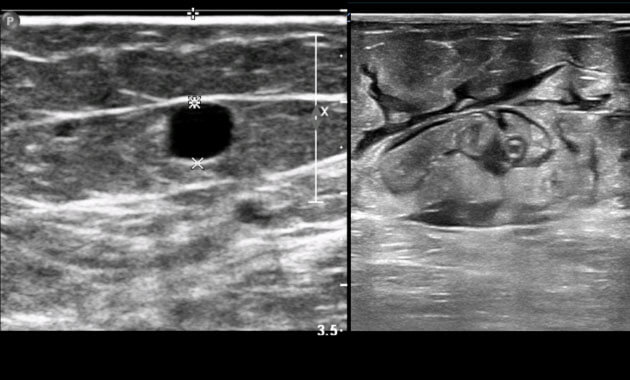Varicose Veins Symptoms & Treatment
Varicose veins result when normal veins become dilated and twisted. Over time, valves in these veins become incompetent. As a result, blood has a difficult time returning to the heart and begins to pool in the veins in the legs, building up pressure. These recruited veins are referred to as varicose veins, and are often visible near the surface of the skin and are most common in the calves and ankles. They can also be present in the thigh and buttock.
Varicose veins are one manifestation of a condition known as chronic venous insufficiency. UCSF interventional radiologists use imaging to diagnose and treat varicose veins, as well as the great saphenous vein (GSV), among a host of other related conditions. These minimally invasive techniques are recognized for achieving outstanding results with shorter recovery times than surgical techniques.
Nearly one third of all adults are thought to be affected by varicose veins, and many are unaware of treatment options.
Endovenous Ablation Benefits
- Rather than surgical ligation and stripping, where the affected vein segment is surgically removed from the body, our practice uses an incision-free technique where the vein is treated from the inside.
- Endovenous ablation is equally as effective as traditional surgery, with shorter recovery times, faster return to work and healing times.
Causes
Many factors cause varicose veins. Obesity, family history, pregnancy, age, and a history of deep venous thrombosis (DVT) or blood clots are all thought to contribute to this process. Varicose veins often run in families, develop over the course of multiple pregnancies, or can develop as a normal part of the aging process.
Symptoms
Symptoms include burning, heaviness, swelling, pain in the legs, discomfort walking, and/or skin changes, including ulcers.
Diagnosis
A doctor can usually diagnose varicose veins by simple visual examination. Other diagnostic tests may also be required, such as a an ultrasound examination of the affected extremity.
Optimal Candidates
Healthy patients with lower extremity venous reflux, or symptoms suggestive of reflux, should consider minimally invasive treatments. For those deemed too high risk for surgery, consider discussing treatment options with your interventional radiologist
Treatments - alternatives to surgery
Radiofrequency Ablation
Radiofrequency ablation (sometimes referred to as RF ablation), is used to treat large veins, such as the great saphenous vein. RF ablation uses heat to treat and close the affected great saphenous vein from the inside.
VenaSealTM
VenaSealTM is an alternative to both surgical stripping with ligation and radiofrequency ablation. Rather than using heat, cyanoacrylate glue is injected into the affected vein segment, and the vein is sealed from the inside. Unlike radiofrequency ablation, which may not be able to treat veins close to the skin, VenaSealTM can be used to treat veins close to the surface.
Vein Sclerosis
For smaller reticular or spider veins, targeted injection of liquid or foam sclerosant medication can be used as effective therapy. Talk to your physician about treatment options and coverage.
Complications
Complications are rare, but can include pain, skin discoloration and blood clot formation.
Prevention
Good blood circulation, fitness and a healthy diet high in fiber can help lower the risk of varicose veins. It can also help to regularly change sitting or standing positions and consider regular use of compression stockings.














